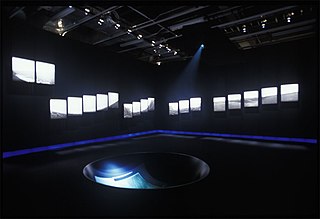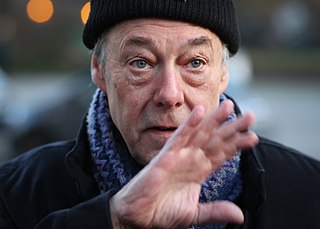Robert Adams is an American photographer who has focused on the changing landscape of the American West. His work first came to prominence in the mid-1970s through his book The New West (1974) and his participation in the exhibition New Topographics: Photographs of a Man-Altered Landscape in 1975. He has received two Guggenheim Fellowships, a MacArthur Fellowship, the Deutsche Börse Photography Prize and the Hasselblad Award.

Stephen Shore is an American photographer known for his images of scenes and objects of the banal, and for his pioneering use of color in art photography. His books include Uncommon Places (1982) and American Surfaces (1999), photographs that he took on cross-country road trips in the 1970s.
Richard Misrach is an American photographer. He has photographed the deserts of the American West, and pursued projects that document the changes in the natural environment that have been wrought by various man-made factors such as urban sprawl, tourism, industrialization, floods, fires, petrochemical manufacturing, and the testing of explosives and nuclear weapons by the military. Curator Anne Wilkes Tucker writes that Misrach's practice has been "driven [by] issues of aesthetics, politics, ecology, and sociology." In a 2011 interview, Misrach noted: "My career, in a way, has been about navigating these two extremes - the political and the aesthetic."

Taku Aramasa is a Japanese photographer.
Kikuji Kawada is a Japanese photographer. He co-founded the Vivo photographic collective in 1959. Kawada's books include Chizu and The Last Cosmology (1995). He was included in the New Japanese Photography exhibition at the Museum of Modern Art, New York in 1974 and was awarded the Lifetime Achievement Award from the Photographic Society of Japan in 2011.
Toshio Shibata is a Japanese photographer known for his large-format photographs of large-scale works of civil engineering in unpopulated landscapes.
Naoya Hatakeyama is a Japanese photographer. His work explores human intervention with the landscape and natural materials, including the life of cities and the built environment.

Todd Hido is an American photographer. He has produced 17 books, had his work exhibited widely and included in various public collections. Hido is currently an adjunct professor at the California College of the Arts in San Francisco.
Graham Howe is a curator, writer, photo-historian, artist, and founder and CEO of Curatorial, Inc., a museum services organization supporting nonprofit traveling exhibitions. Curatorial Inc. manages the E.O. Hoppé Estate Collection and the Paul Outerbridge II Collection among others. Born in Sydney, Australia, Howe now resides in Los Angeles and London.
Andrea Modica is an American photographer and professor of photography at Drexel University. She is known for portrait photography and for her use of platinum printing, created using an 8"x10" large format camera. Modica is the author of many monographs, including Treadwell (1996) and Barbara (2002).
John Divola is an American contemporary visual artist and educator, living in Riverside, California. He works in photography, describing himself as exploring the landscape by looking for the edge between the abstract and the specific. He is a professor in the art department at University of California Riverside.

Gerald David "Gerry" Badger is an English writer and curator of photography, and a photographer.
John Wimberley is an American fine art photographer with a focus on landscapes and human figures, as well as mining camps and Native American rock art from the American West. His work is included in the permanent collections of the Portland Art Museum, the Museum of Fine Arts Houston, the Yale University Art Gallery, among others.

David Maisel is an American photographer and visual artist whose works explore vestiges and remnants of civilizations both past and present. His work has been the subject of five major monographs, published by Nazraeli Press, Chronicle Books, and Steidl.

William Jay was a photographer, writer on and advocate of photography, curator, magazine and picture editor, lecturer, public speaker and mentor. He was the first editor of "the immensely influential magazine" Creative Camera (1968–1969); and founder and editor of Album (1970–1971). He is the author of more than 20 books on the history and criticism of photography, and roughly 400 essays, lectures and articles. His own photographs have been widely published, including a solo exhibition at the San Francisco Museum of Modern Art. He is known for his portrait photographs of photographers.
Jason Langer is an American photographer best known for this psychological and noirish visions of contemporary urban life.
Anthony Hernandez is an American photographer who divides his time between Los Angeles, his birthplace, and Idaho. His photography has ranged from street photography to images of the built environment and other remains of civilization, particularly those discarded or abandoned elements that serve as evidence of human presence. He has spent most of his career photographing in Los Angeles and environs. "It is L.A.'s combination of beauty and brutality that has always intrigued Hernandez." La Biennale di Venezia said of Hernandez, "For the past three decades a prevalent question has troubled the photographer: how to picture the contemporary ruins of the city and the harsh impact of urban life on its less advantaged citizens?" His wife is the novelist Judith Freeman.

Jamey Stillings is an American photographer and artist known primarily for his aerial photography of renewable energy projects around the world, documenting the human impact on the environment. Stillings presents at photo festivals, universities, and professional conferences globally. His work is exhibited and published widely in Asia, Australia, Europe, and North and South America. His award-winning book, The Evolution of Ivanpah Solar, documents the Ivanpah Solar Electric Generating System in the Mojave Desert of California. His photographs are in private and public collections, including the United States Library of Congress, Museum of Fine Arts - Houston, Los Angeles County Museum of Art, and Nevada Museum of Art.
Emi Anrakuji is a Tokyo-based legally blind Japanese photographer who makes self-portraits. She has produced a number of books with Nazraeli Press and her work is held in the collection of the Museum of Fine Arts, Houston. In 2006 Anrakuji won the New Photographer Prize of the Higashikawa Prize in Higashikawa, Japan.
Lucas Foglia is an American photographer, living in San Francisco. "His work is concerned mainly with documenting people and their relationship to nature", for which he has travelled extensively making landscape photography and portraiture.







